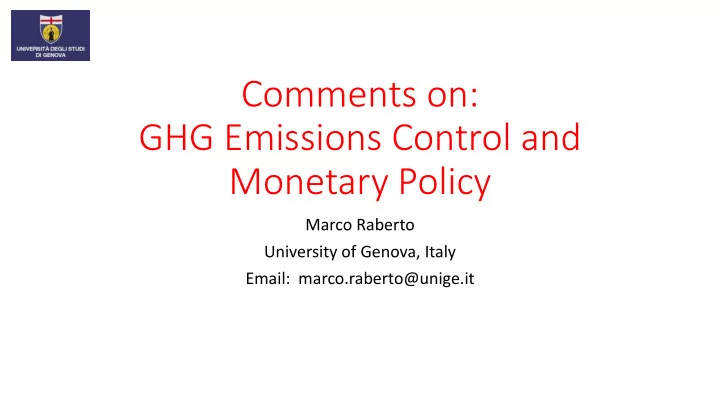

Comments on: GHG Emissions Control and Monetary Policy Marco Raberto University of Genova, Italy Email: marco.raberto@unige.it
Relevant features of the model • It addresses the optimal policy combination between monetary and environmental (fiscal) policies in a new- Keynesian framework characterized by: • nominal price rigidities with costly price adjustments • imperfect competition in the intermediate goods sector • negative externality of emissions on labor productivity • Calibration and sensitivity analysis of parameters • Pareto efficient equilibrium with flexible prices also discussed and compared
Most relevant results • Strict inflation targeting is not the optimal monetary policy in the cases of a cap-and-trade environmental policy or a carbon tax policy in a setting with a severe damage by pollution. • Main point: trade-off between the cost of adjusting prices and the cost of abating emissions • Emissions are usually procyclical but may turn out to be countercyclical if the Ramsey planner controls only environmental policy and monetary policy is highly reactive. • Main point: the opportunity cost of abatament reduces
Some questions and criticisms • Could you provide some intuition why setting the emission target is equivalent to setting the carbon tax when the Ramsey planner controls both monetary and environmental policy? • Does it matter with the pro-ciclicality of emissions in this case? • Shortcoming of IAMs (Farmer et al. 2015, Pindyck 2015) • uncertainty about extreme climate outcomes • distributional issues • equilibrium • endogenous technological change and path dependencies • financial and banking sectors matter • ……. • Could IAMs or your model address some of the above issues in future research?
Are there valid alternative to traditional IMAs ? • Agent-based macro-models with environmental features, e.g. • EURACE (Raberto et al., 2016, Ponta et al. 2016) • K+S (Lamperti et al. 2016) • SFC sector-based models, e.g. • Dafermos et al. 2017 • Jackson and Victor 2015 • Godin et al 2016 • SD: GRO (Pasqualino et al. 2016) • AB-SD: Eirin (Monasterolo and Raberto 2016) Shortcomings: ad-hoc behavioral rules, too many variables/parameters, very difficult calibration
Recommend
More recommend